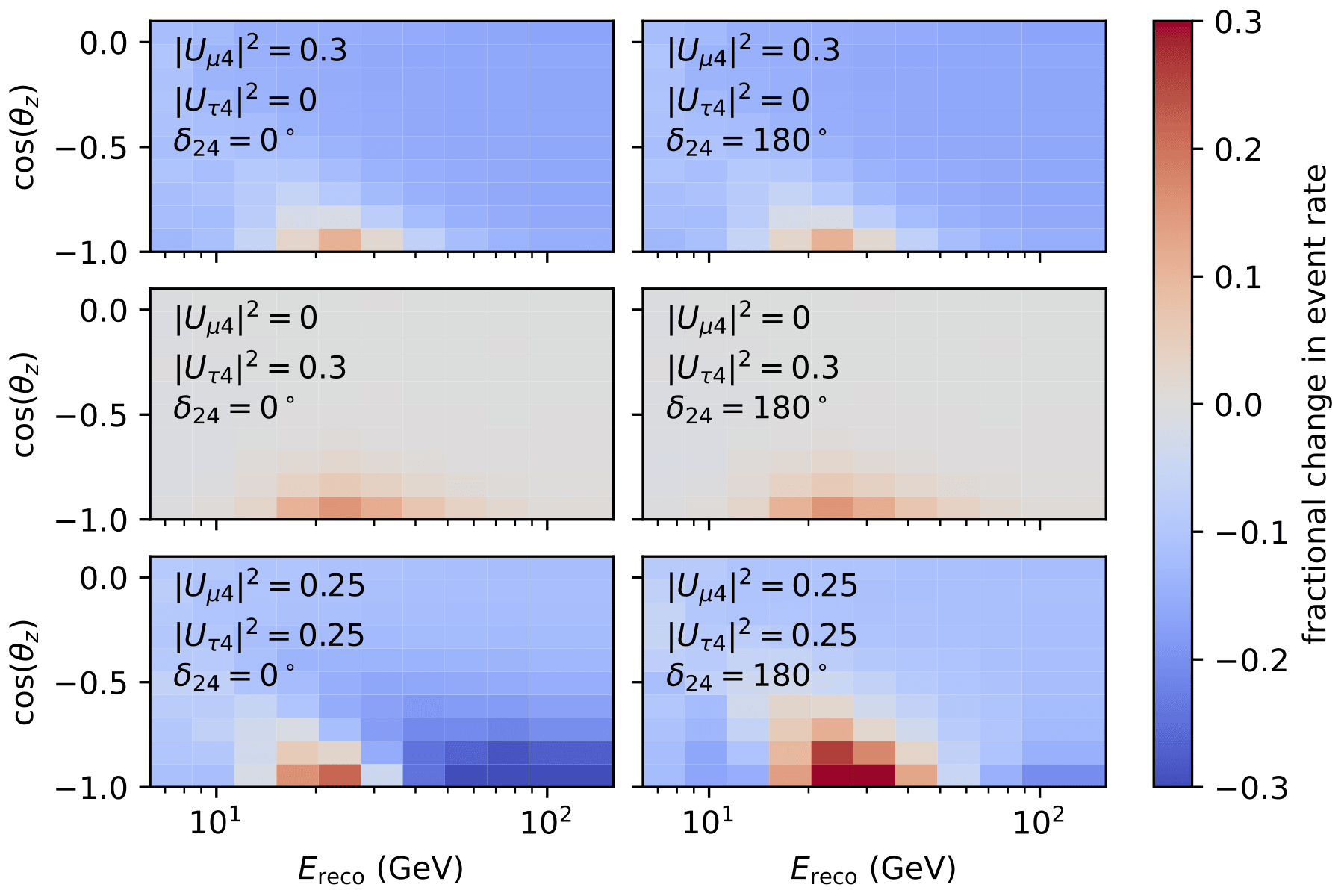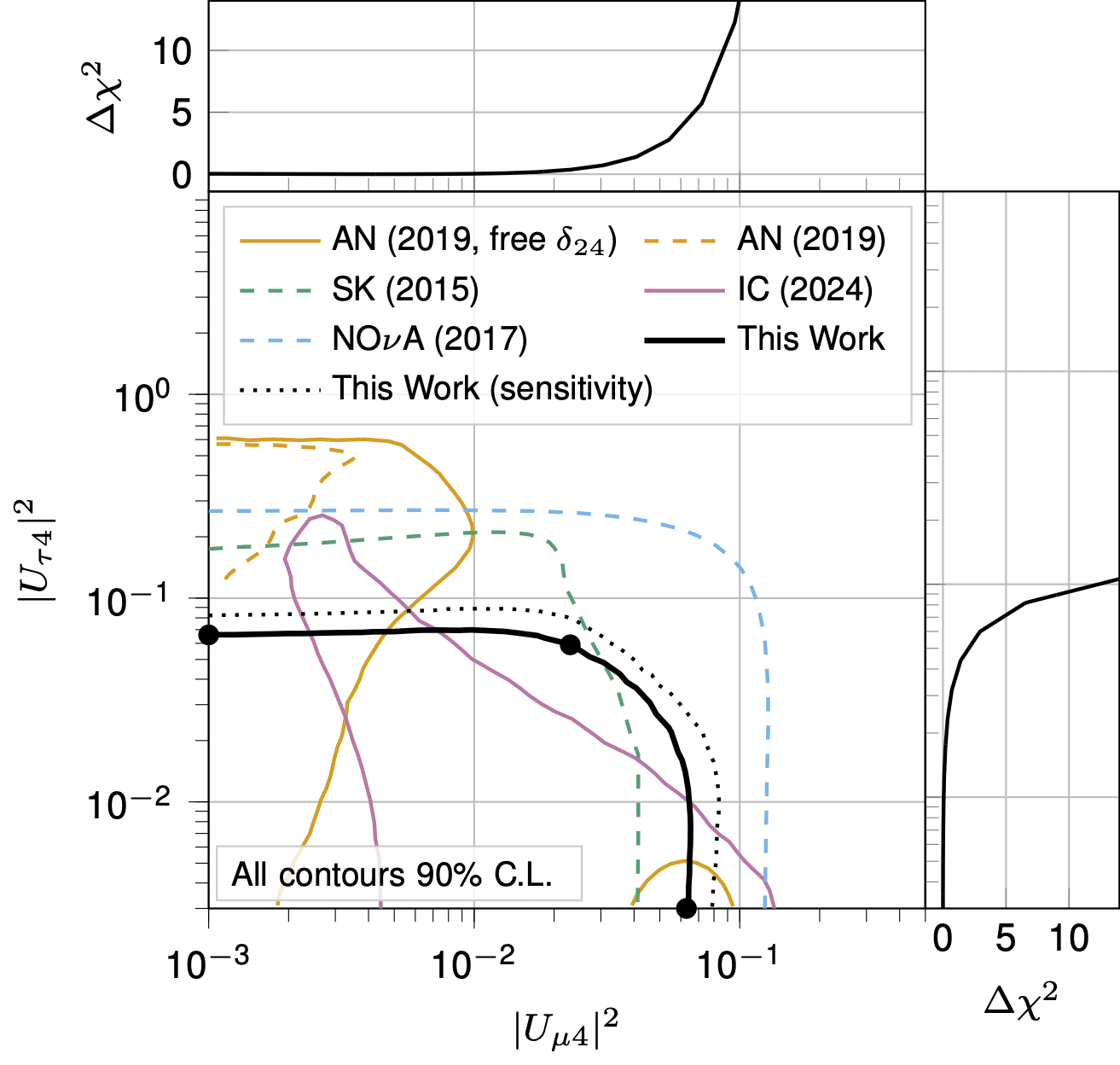When cosmic rays crash into the Earth’s atmosphere, air showers containing atmospheric muons and neutrinos are produced that rain down on Earth. During their journey, atmospheric neutrinos can morph or “oscillate” between three different flavors: electron, muon, and tau. These neutrinos can interact weakly with other particles and, thus, are still observable by detectors such as the IceCube Neutrino Observatory at the South Pole.
However, a fourth neutrino flavor that shies away from direct interactions, called the “sterile” neutrino, has been proposed to explain anomalies observed in short baseline neutrino experiments. Sterile neutrinos could still have an indirect, measurable effect if the three known flavors are able to oscillate into a sterile neutrino and vice versa. To help uncover this mystery, many different experimental methods are needed to measure neutrino oscillations.
In a study submitted today to Physical Review D, the IceCube Collaboration presents a search for the sterile neutrino using 7.5 years of data from IceCube’s DeepCore detector, a subdetector that is sensitive to neutrinos down to energies of only a few GeV. The results are compatible with the absence of mixing between active and sterile neutrino states.

The analysis used data from DeepCore containing a sample of over 20,000 well-reconstructed events with energies between 5 and 150 GeV. In this energy range, muon neutrinos that are produced in the atmosphere of the Earth have a high probability of oscillating into other flavors, which is observed in the data as a disappearance that depends on the energy of the neutrino and the distance it has traveled between the point where it was produced and where it was detected in IceCube. Improvements in event selection and treatment of systematic uncertainties provide greater statistical power compared to previous DeepCore sterile neutrino searches.

“If the hypothetical sterile neutrino did exist and was participating in neutrino oscillations, then we should see a change in this disappearance pattern,” says Alexandra Trettin, who led the study as a PhD student at Deutsches Elektronen-Synchrotron (DESY). Trettin is now a postdoctoral researcher at the University of Manchester.
“For high-energy neutrinos that travel a shorter distance, we would see fewer muon neutrinos because they would oscillate into sterile neutrinos. But for neutrinos at intermediate energies that enter the detector from below, we would actually see more muon neutrinos than we would normally expect, because sterile neutrinos would oscillate into muon neutrinos.”
To test this hypothesis, Trettin and collaborators looked at a large set of simulated neutrinos and changed the probability of neutrinos oscillating into and from the sterile neutrino flavor in the simulation. They also changed the parameters of the simulation until the distribution of real data and simulation were statistically indistinguishable to get the final result of the measurement.

“We found that the data we observed are compatible with the absence of sterile neutrinos and set limits on the maximum amount of mixture between sterile and nonsterile neutrinos that our data allows,” says Trettin. “While these limits are not yet strong enough to fully rule out the possibility that sterile neutrinos were responsible for the anomalies observed in some other experiments, they still add to the existing tension between the anomalous and non-anomalous results.”
“This result further constrains the available phase space where an eV-scale sterile neutrino could be hiding,” says Summer Blot, a staff scientist at DESY and Trettin’s PhD advisor. “However, because the broader landscape of sterile neutrino searches is still conflicted, with hints of a signal from some measurements and strong exclusions from others, it remains important to continue testing the three-neutrino paradigm with new data and improved analysis techniques.”
The IceCube Upgrade, set for installation in 2025-26, will enable IceCube to detect many more GeV-scale atmospheric neutrinos with improved precision and thereby significantly enhance its sensitivity to the signature of light sterile neutrinos.
+ info “Search for a light sterile neutrino with 7.5 years of IceCube DeepCore data,” IceCube Collaboration: R. Abbasi et al., Submitted to Physical Review D, arxiv.org/abs/2407.01314